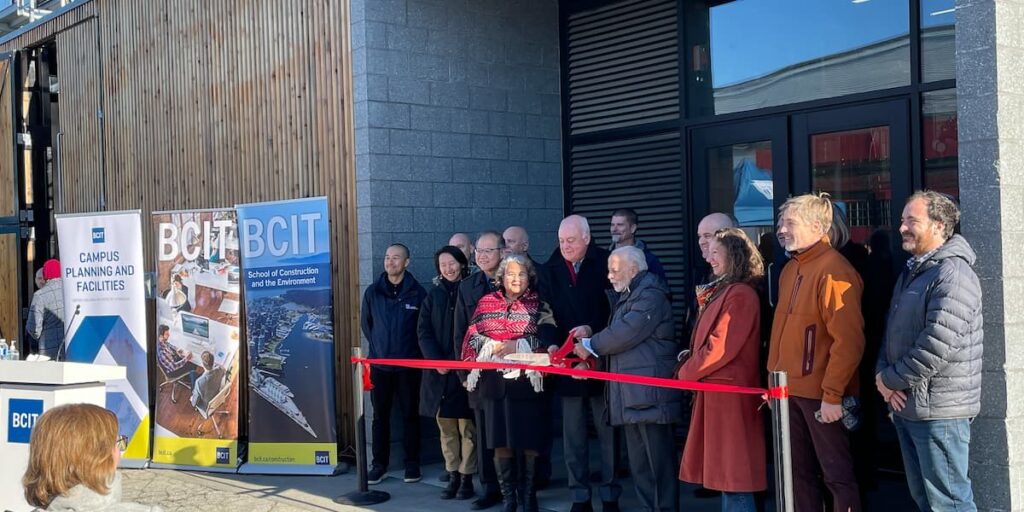
Keeping in line with its commitment to sustainable projects, the British Columbia Institute of Technology (BCIT) has opened a new $1.5 million Wood Waste to Energy Centre (the Centre) at its Burnaby Campus.
Each year, the Centre will recycle 250 tons of wood off-cuts and sawdust from BCIT Carpentry and Joinery programs into clean energy to heat buildings at the Burnaby Campus.
The BC Ministry of Environment and Climate Change Strategy’s Carbon Neutral Government (CNG) program provided $340,000 towards the project, which also brings to life elements of the Province’s Clean BC plan. The project also received $200,000 in funding from the BC Bioenergy Network.
The Centre currently creates enough clean energy to heat two Burnaby campus buildings, which reduces BCIT’s total annual greenhouse gas (GHG) emissions by one percent, or 75 tonnes of carbon dioxide equivalent (tCO2e). However, there’s potential in the future to save up to 240 tCO2e annually, or three percent of BCIT’s total emissions. The project will also reduce transportation emissions because the wood waste will no longer need to be trucked away from campus for disposal.
“This is an exciting project because it delivers significant GHG reductions while creating a more sustainable learning environment for students in our trades programs,” says Danica Djurkovic, BCIT Vice President, Campus Planning and Facilities. “We were delighted to work with the School of Construction and the Environment to develop this system, which we believe could be adopted to use on a much larger scale in industries that produce wood waste. We will continue to prioritize reducing the Institute’s carbon footprint through future projects, like the electrification of the main heating plant at the Burnaby campus, and designing new buildings that meet net-zero emissions standards.”
Learn more about innovative and sustainable initiatives at the BCIT Burnaby campus
The Centre’s clean energy production has three main processes:
- Clean, kiln-dried lumber off-cuts are sent to a chipper and cut into inch-long chips which are then stored in a silo and fed into the biomass boiler by an auger
- The wood chips are burned to heat the water in the boiler, and fan unit heaters blow air over the hot water coils to deliver warm air to the Carpentry and Joinery shop spaces
- The exhaust from the boiler system is run through a multi-stage filter to ensure that it meets strict emissions regulations from Metro Vancouver
A partnership project
The Centre is a result of a close partnership between the BCIT Campus Planning and Facilities Department and the BCIT School of Construction and the Environment. Students played an important role in the project by building the timber structure for the roof of the boiler house, fabricating and erecting the steel structure for the chipper enclosure, improving the chipper metal hopper, completing the air dispersion modelling required for the permitting, completing a noise control study, and much more.
“The low-carbon heating system serves as a great example of a living lab. Trades and technology students were involved in the planning, design and construction of the facility.”
Wayne Hand, Dean, BCIT School of Construction and the Environment is particularly proud of the student involvement in the project. “The low-carbon heating system serves as a great example of a living lab,” says Wayne. “Trades and technology students were involved in the planning, design, and construction of the facility. Now that the facility is operational, BCIT students get to visit the site on a regular basis to learn about the maintenance and operation of a biomass-driven pressure vessel. This is the final element of a series of clean tech projects that reduced the School of Construction and Environment’s GHG emissions by more than 75 percent in the buildings where we teach Welding, Piping, Carpentry, and Joinery programs.”
Climate action and adaptation remain at the forefront of the Institute’s academic and operational plans. Projects like the Centre show BCIT’s commitment in addressing the sustainability challenges we face here on campus, across BC, and around the world.
“Once again, BCIT is leading the way by actioning new ways to tackle the climate crisis,” says Burnaby-North MLA, Janet Routledge, in a celebratory message to the BCIT community. “Every day you demonstrate your commitment to saving our planet. BCIT sets a standard that inspires us all and gives us hope at a time when it is desperately needed. Equally important, BCIT is training the next generation of environmental experts who will have the skills to meet existential challenges on behalf of us all. Congratulations to everyone involved in this wonderful initiative!”
This facility is a testament to the collaboration between BCIT students, faculty, and government, to build the necessary infrastructure to propel our journey towards a cleaner, greener province, and a sustainable future.